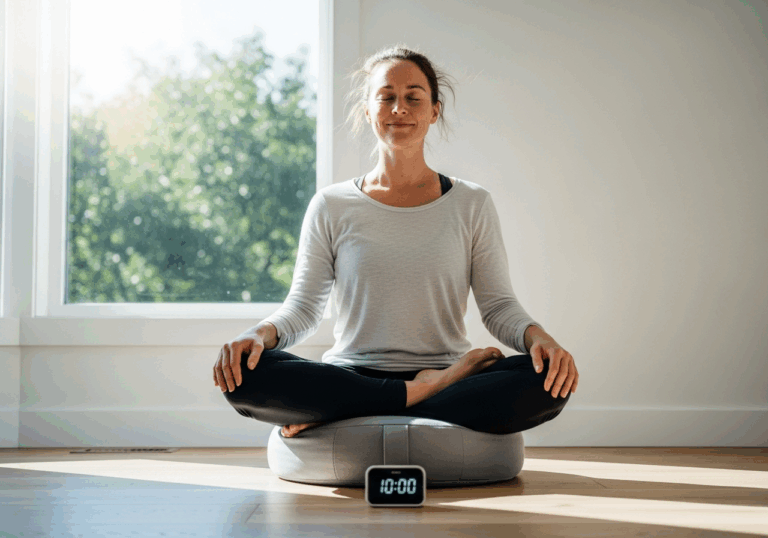Science-Backed Tips
Transform Anxiety with Virtual Reality Therapy
VR interventions show a 79% reduction in anxiety symptoms.
📊 Did you know?
💡 Why It Matters
1️⃣
The NNT (Number Needed to Treat) for VR interventions is approximately 2.4, meaning that for every 2-3 individuals treated, one will experience significant anxiety relief.
2️⃣
Improving mood through VR can enhance overall quality of life, potentially reducing healthcare costs associated with anxiety disorders.
3️⃣
Exposure-based VR interventions can provide a scalable solution for mental health treatment, addressing the growing demand for accessible therapy options.
✅ Try These Micro-Tips
🎯
Engage in VR therapy sessions for at least 30 minutes, 2-3 times a week.
🎯
Incorporate guided VR mindfulness exercises to complement traditional therapy approaches.
🎯
Track your anxiety levels before and after VR sessions to measure progress.
🎯
Consider using VR apps designed specifically for anxiety management.
📚 The study
What does this mean for those seeking relief? The Number Needed to Treat (NNT) for VR interventions stands at approximately 2.4, indicating that for every 2 to 3 individuals who undergo treatment, one will experience significant anxiety relief.
This strong overall efficacy highlights the potential of exposure-based VR interventions to uplift mood and enhance overall quality of life. Moreover, as mental health issues continue to rise, VR offers a scalable solution that can meet the growing demand for accessible therapy options. By improving mood through innovative VR experiences, we can not only help individuals reclaim their lives but also potentially reduce healthcare costs associated with anxiety disorders.
As we delve deeper into the future of mental health treatment, the promise of VR technology shines brightly, offering hope and healing to those in need.
❓ Frequently Asked Questions ❓
Learn more
What is the efficacy of VR interventions for anxiety?
Meta-analytical evidence shows that VR interventions have a strong therapeutic effect, with a Hedges’ g of 0.79. This indicates significant anxiety reduction post-treatment, making VR a promising option for mental health care.
What does NNT mean in the context of VR interventions?
NNT stands for Number Needed to Treat, which in this case is approximately 2.4. This means that for every 2-3 individuals treated with VR, one will experience significant relief from anxiety.
How often should I engage in VR therapy sessions?
It is recommended to engage in VR therapy sessions for at least 30 minutes, 2-3 times a week. Consistent practice can enhance the therapeutic benefits of VR interventions.
Can VR interventions help with depression as well?
Yes, the efficacy of VR interventions is similar for both anxiety and depression. The meta-analysis indicates that VR can effectively improve mood and reduce symptoms of depression.
What are exposure-based VR interventions?
Exposure-based VR interventions involve immersing individuals in virtual environments that help them confront and manage their anxiety triggers. This approach has shown robust therapeutic effects in reducing anxiety levels.
How can VR improve overall quality of life?
Improving mood through VR interventions can lead to enhanced overall quality of life by alleviating symptoms of anxiety and depression. This may also contribute to reduced healthcare costs associated with mental health disorders.
Are there specific VR apps for anxiety management?
Yes, there are VR apps specifically designed for anxiety management that provide guided experiences and exercises. These apps can be used to complement traditional therapy approaches.
How can I track my progress with VR therapy?
You can track your anxiety levels before and after VR sessions to measure progress over time. Keeping a journal or using apps to log your feelings can help you assess the effectiveness of the therapy.
What is the significance of a Hedges’ g of 0.79?
A Hedges’ g of 0.79 indicates a strong effect size, suggesting that VR interventions are highly effective in reducing anxiety. This level of efficacy is comparable to other established therapeutic methods.
Why is there a growing demand for VR therapy options?
The growing demand for VR therapy options is driven by the need for accessible and scalable mental health treatments. VR provides a unique solution that can reach individuals who may not have access to traditional therapy.





